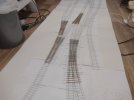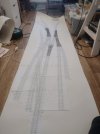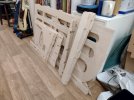You are using an out of date browser. It may not display this or other websites correctly.
You should upgrade or use an alternative browser.
You should upgrade or use an alternative browser.
The Chronicles of Canary Sidings - the Tale of an Untidy Workbench
- Thread starter Herb Garden
- Start date
-
- Tags
- 4mm scale em gauge ger pre-grouping
Threadmarks
View all 32 threadmarks
Reader mode
Reader mode
Recent threadmarks
2024.14 - Road traffic on Burnt House Lane 2024.15 - Skeetsmere - ground cover and ballast 2024.16 - Skeetsmere - architectural planning 2024.17 - Skeetsmere - power and control 2024.18 - Experiments with 2mmfs 2024.19 - Drewery 0-4-0DM 2024.20 - Skeetsmere - more electronics 2024.21 - WagonsHerb Garden
Western Thunderer
I don't think its the lack of gauges.... I have some very nice milled steel pieces that I use....
More likely it's me trying to do it whilst I'm tired and stressed ....
More likely it's me trying to do it whilst I'm tired and stressed ....
Herb Garden
Western Thunderer
Well here is some progress .... It's been another awful week but at least I've made some progress with the trackwork
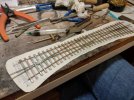
That's where I got to last night.
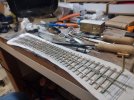
And a few more hours work today
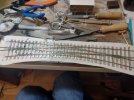
The good news is there is only 1 working week left until the shutdown and even better I'm going to go and collect parts for the baseboards on Monday..... Watch this space

That's where I got to last night.

And a few more hours work today

The good news is there is only 1 working week left until the shutdown and even better I'm going to go and collect parts for the baseboards on Monday..... Watch this space
James Spooner
Western Thunderer
George,Well here is some progress .... It's been another awful week but at least I've made some progress with the trackwork
View attachment 204092
That's where I got to last night.
View attachment 204094
And a few more hours work today
View attachment 204095
The good news is there is only 1 working week left until the shutdown and even better I'm going to go and collect parts for the baseboards on Monday..... Watch this space
That is looking really good and you should be proud of what you have achieved there, despite current challenges. Well done and I look forward to seeing the completed article!
Nigel
Herb Garden
Western Thunderer
Herb Garden
Western Thunderer
So work on the final cross over has commenced
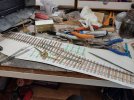
Not bad for first thing in the morning eh?
I know you are all going to be glad once I finish the track work as it must make rather dull reading. But I've really enjoyed this bit of the project and am a bit sad that there's no more to do.... Will have to design an extension for the layout won't I?
Well that's all for now.... Now to face another hellish working week.... Just telling myself: 5 days left, 5 days left.

Not bad for first thing in the morning eh?
I know you are all going to be glad once I finish the track work as it must make rather dull reading. But I've really enjoyed this bit of the project and am a bit sad that there's no more to do.... Will have to design an extension for the layout won't I?
Well that's all for now.... Now to face another hellish working week.... Just telling myself: 5 days left, 5 days left.
Herb Garden
Western Thunderer
Dave Sutton
Active Member
I note the guitar in the background.........No Stairway...

Herb Garden
Western Thunderer
It's a 4 string electric tenor tuned like a viola.... so no stairway to heaven I'm afraidI note the guitar in the background.........No Stairway...
paulc
Western Thunderer
Excellent work there George , now you just have to work out where all isolation gaps go .Well here is some progress .... It's been another awful week but at least I've made some progress with the trackwork
View attachment 204092
That's where I got to last night.
View attachment 204094
And a few more hours work today
View attachment 204095
The good news is there is only 1 working week left until the shutdown and even better I'm going to go and collect parts for the baseboards on Monday..... Watch this space
Herb Garden
Western Thunderer
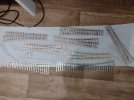
So all the P&C work is now done for skeetsmere so that's another milestone this week.
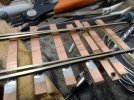
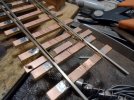
I've also taken the advice of @JimG and fitted a tie bar within pivots to one of the points and it works wonders so much easier to throw. Jim you were right thanks.
Also for those curious about my unusual guitar here's a close up
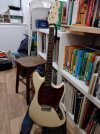
Herb Garden
Western Thunderer
In that regard, musical instruments are a lot like model train projects.... Easier to acquire harder to get working in active service...The main thing I have come to know about musical instruments is that they are much easier to acquire than is the necessary talent to use them.
I do wholly agree about pivoted point blades, however!
Herb Garden
Western Thunderer
So the factory is now closed for the year and I finally get my annual modelling week. Mixed around various family events of course.
So this afternoon I did a dry run on slotting the baseboards together. So to answer the inevitable question they are my own custom design for which I did the artwork but we're cut for the team at PLYable Design in Blyth. And the fact they fit together so well and are finished so beautifully is a testament to their craftsmanship.
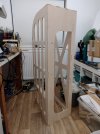
So this is the longer station board. On end as I don't have space to lie it down and take a photo
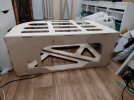
Next we have the mill board with it's split levels and the exit hole on the front for when the layout is connected to the rest of the (proposed) layout. The tapered front of both should allow me to bring the lighting forward of the front of the layout so we shouldn't get any front shadows. Well that's the plan anyhow.
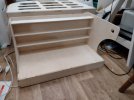
So I had space on the sheet when I did the original nests so I designed myself a fiddle yard board for when this layout (might if it's good enough) go out on exhibitions.... It will also enable running the layout whist the rest of the larger system gets built (or doesn't).
There is space for 5 cassettes which will cover a full 1919 Tuesday (market day) MSLR timetables worth of trains. Namely
- morning cattle train
- passenger/mixed set
- daily goods (morning)
- daily goods afternoon
- contractors train
I've based this as I said on the MSLR 1919 timetable.
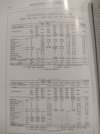
Which is probably the most complicated the line ever had and it features some fun things such as the Tuesday cattle movement and the engine swap at Kenton on the Tuesday and Thursday afternoons allowing the laxfield loco to return up the line for the next mixed service. Using this Skeetsmere replaces laxfield.
So here is a brain teaser for you. According to this WT how does the Kenton loco get to laxfield for the early morning cattle service?
So this afternoon I did a dry run on slotting the baseboards together. So to answer the inevitable question they are my own custom design for which I did the artwork but we're cut for the team at PLYable Design in Blyth. And the fact they fit together so well and are finished so beautifully is a testament to their craftsmanship.

So this is the longer station board. On end as I don't have space to lie it down and take a photo

Next we have the mill board with it's split levels and the exit hole on the front for when the layout is connected to the rest of the (proposed) layout. The tapered front of both should allow me to bring the lighting forward of the front of the layout so we shouldn't get any front shadows. Well that's the plan anyhow.

So I had space on the sheet when I did the original nests so I designed myself a fiddle yard board for when this layout (might if it's good enough) go out on exhibitions.... It will also enable running the layout whist the rest of the larger system gets built (or doesn't).
There is space for 5 cassettes which will cover a full 1919 Tuesday (market day) MSLR timetables worth of trains. Namely
- morning cattle train
- passenger/mixed set
- daily goods (morning)
- daily goods afternoon
- contractors train
I've based this as I said on the MSLR 1919 timetable.

Which is probably the most complicated the line ever had and it features some fun things such as the Tuesday cattle movement and the engine swap at Kenton on the Tuesday and Thursday afternoons allowing the laxfield loco to return up the line for the next mixed service. Using this Skeetsmere replaces laxfield.
So here is a brain teaser for you. According to this WT how does the Kenton loco get to laxfield for the early morning cattle service?
2023.11 - GER B26 class #407
Herb Garden
Western Thunderer
Seasons greetings everyone!
(Just in case anyone is still reading this)
So there has been some progress on Skeetsmere been made but much of is planning positioning of servo motor and wiring routing so not very exciting stuff. More to follow in due course.
Instead let me tell you about the other project I've restarted over the festive season.
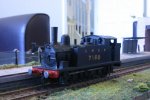
Back in 2011 when I was still a student I purchased my first GER loco; This little buckjumper built from a wills finecast kit. (This was before Hornby brought out it's J15).
Well it ended up running around on a rather terrible layout a few of us students had built where it was highly inappropriate but hey I loved it even if it did run like a bag of spanners
Moving into more finescale modelling I looked about comming up with a use for it. And hit upon this.
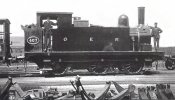
This little beauty is B26 a sub-class of the GER R24 breed (J67/2 for those of you who speak LNER) basically a shunting version of the more famous passenger fitted buckjumper. The key differences being the flat tank profile, 15 spoke unbalanced wheels and lever reverse.
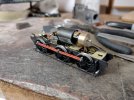
After years in store. I built a new chassis for her soon after I joined local EM area group and thanks to the advice of my friends there it runs like a dream. But something was clashing with the body shell and the pair weren't running together so instead of being sensible and solving the issue the loco went back in the box and I got distracted with other things.... Very typical me I'm afraid....
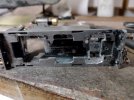
However, after a year or so in the box I have dug her out again and started work. The problem was that the footplate was clashing in some places with the wheel flanges causing a short.
Now for years I've shied away from using my Dremel but this holiday I've mastered it and been able to use here to gently mill away some material to clear the wheel flanges.
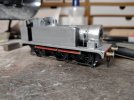
And hey presto it fits!
So in-between work on skeetsmere #407 might get finished.... Well we can hope.... But it will be a useful loco to work the goods services on skeetsmere until I can get round to building a MSLR tank loco or two.
(Just in case anyone is still reading this)
So there has been some progress on Skeetsmere been made but much of is planning positioning of servo motor and wiring routing so not very exciting stuff. More to follow in due course.
Instead let me tell you about the other project I've restarted over the festive season.

Back in 2011 when I was still a student I purchased my first GER loco; This little buckjumper built from a wills finecast kit. (This was before Hornby brought out it's J15).
Well it ended up running around on a rather terrible layout a few of us students had built where it was highly inappropriate but hey I loved it even if it did run like a bag of spanners
Moving into more finescale modelling I looked about comming up with a use for it. And hit upon this.

This little beauty is B26 a sub-class of the GER R24 breed (J67/2 for those of you who speak LNER) basically a shunting version of the more famous passenger fitted buckjumper. The key differences being the flat tank profile, 15 spoke unbalanced wheels and lever reverse.

After years in store. I built a new chassis for her soon after I joined local EM area group and thanks to the advice of my friends there it runs like a dream. But something was clashing with the body shell and the pair weren't running together so instead of being sensible and solving the issue the loco went back in the box and I got distracted with other things.... Very typical me I'm afraid....

However, after a year or so in the box I have dug her out again and started work. The problem was that the footplate was clashing in some places with the wheel flanges causing a short.
Now for years I've shied away from using my Dremel but this holiday I've mastered it and been able to use here to gently mill away some material to clear the wheel flanges.

And hey presto it fits!
So in-between work on skeetsmere #407 might get finished.... Well we can hope.... But it will be a useful loco to work the goods services on skeetsmere until I can get round to building a MSLR tank loco or two.
James Spooner
Western Thunderer
I give up. How did the Kenton engine get to Laxfield? Was it just a very early start or did it sleep over?So the factory is now closed for the year and I finally get my annual modelling week. Mixed around various family events of course.
So this afternoon I did a dry run on slotting the baseboards together. So to answer the inevitable question they are my own custom design for which I did the artwork but we're cut for the team at PLYable Design in Blyth. And the fact they fit together so well and are finished so beautifully is a testament to their craftsmanship.
View attachment 204712
So this is the longer station board. On end as I don't have space to lie it down and take a photo
View attachment 204713
Next we have the mill board with it's split levels and the exit hole on the front for when the layout is connected to the rest of the (proposed) layout. The tapered front of both should allow me to bring the lighting forward of the front of the layout so we shouldn't get any front shadows. Well that's the plan anyhow.
View attachment 204714
So I had space on the sheet when I did the original nests so I designed myself a fiddle yard board for when this layout (might if it's good enough) go out on exhibitions.... It will also enable running the layout whist the rest of the larger system gets built (or doesn't).
There is space for 5 cassettes which will cover a full 1919 Tuesday (market day) MSLR timetables worth of trains. Namely
- morning cattle train
- passenger/mixed set
- daily goods (morning)
- daily goods afternoon
- contractors train
I've based this as I said on the MSLR 1919 timetable.
View attachment 204716
Which is probably the most complicated the line ever had and it features some fun things such as the Tuesday cattle movement and the engine swap at Kenton on the Tuesday and Thursday afternoons allowing the laxfield loco to return up the line for the next mixed service. Using this Skeetsmere replaces laxfield.
So here is a brain teaser for you. According to this WT how does the Kenton loco get to laxfield for the early morning cattle service?
Herb Garden
Western Thunderer
So after lots of delicate filing I've reshaped the tank tops to match the correct profile for this loco. The curvy top was a design feature to cover the condenser equipment and was not added to locos not built with that feature fitted like the B26s
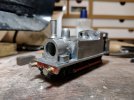
A little issue is that when this loco was disassembled and stripped of paint the small parts where all put away in store.... Over time these have migrated into various different parts boxes so much so that it has taken a long time to find chimney, dome, buffer, sandbox and cab roof. And currently I can only find 3 out of 4 steps...
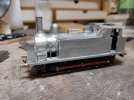
You will note the cab roof. Or rather the hole in it. One of the weaknesses of the old wills finecast kit (which has now been corrected on the SE finecast version) is there was no cabside over the top of the cab opening just roof. So my plan is to reattach the roof and blend it in to put this material back then put a brass roof over the top. The hole is where I'm removing the center of the roof so I can paint and detail the cab interior.
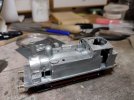
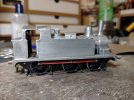

A little issue is that when this loco was disassembled and stripped of paint the small parts where all put away in store.... Over time these have migrated into various different parts boxes so much so that it has taken a long time to find chimney, dome, buffer, sandbox and cab roof. And currently I can only find 3 out of 4 steps...

You will note the cab roof. Or rather the hole in it. One of the weaknesses of the old wills finecast kit (which has now been corrected on the SE finecast version) is there was no cabside over the top of the cab opening just roof. So my plan is to reattach the roof and blend it in to put this material back then put a brass roof over the top. The hole is where I'm removing the center of the roof so I can paint and detail the cab interior.


Herb Garden
Western Thunderer
In short I don't know.I give up. How did the Kenton engine get to Laxfield? Was it just a very early start or did it sleep over?
There's no working on the Monday that would get that loco up to laxfield that I can see unless it was done earlier in the week.
I acquired an excellent book from @Eastsidepilot on historical railway modelling by David Jenkinson recently and that talks about plotting train graphs to show train movements. I might have to do something like that to work it out
Herb Garden
Western Thunderer
So you will notice from the photos that another issue with the old wills finecast kit is there is no relief between the footplate and vallance and it's all one flush casting so that needs modifying.
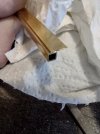
So I've made myself a highly technical filing guide. Piece of brass box with piece of strip the width of intended footplate soldered to it.
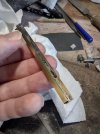
This then gets placed along the tank side
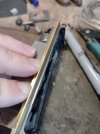
And using a file with a safe edge it seems to work
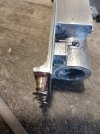
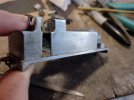
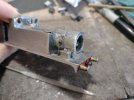
Still a bit more to do but you get the idea

So I've made myself a highly technical filing guide. Piece of brass box with piece of strip the width of intended footplate soldered to it.

This then gets placed along the tank side

And using a file with a safe edge it seems to work



Still a bit more to do but you get the idea
Herb Garden
Western Thunderer
So today's modelling time has been spent making running repairs
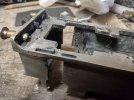
You can just see in the photos two cracks in the footplate where the recess is .... Basically the casting has become really weak due to all the material I've removed.
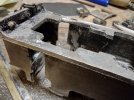
So after a lot of patient layering up of white metal solder which didn't want to go where it was needed rather anywhere else. Probably due to the fact WM solder doesn't flow in the same way as normal solder. But it's fixed now.
Btw does anyone know a trick for quickly removing WM bits from the teeth of files? Mine are all getting clogged again...

You can just see in the photos two cracks in the footplate where the recess is .... Basically the casting has become really weak due to all the material I've removed.

So after a lot of patient layering up of white metal solder which didn't want to go where it was needed rather anywhere else. Probably due to the fact WM solder doesn't flow in the same way as normal solder. But it's fixed now.
Btw does anyone know a trick for quickly removing WM bits from the teeth of files? Mine are all getting clogged again...
Threadmarks
View all 32 threadmarks
Reader mode
Reader mode

